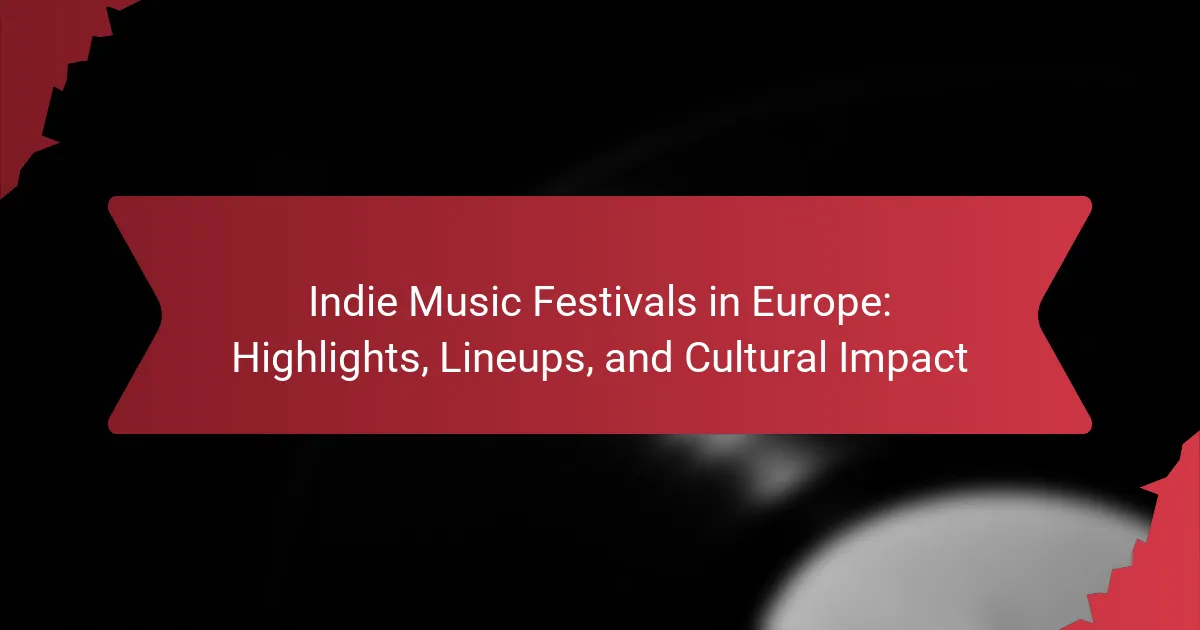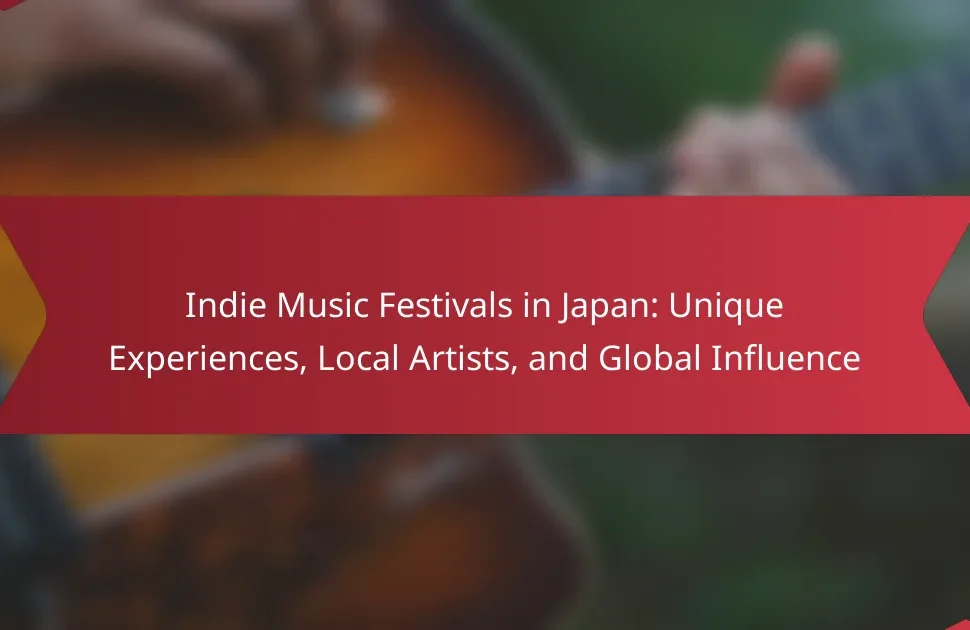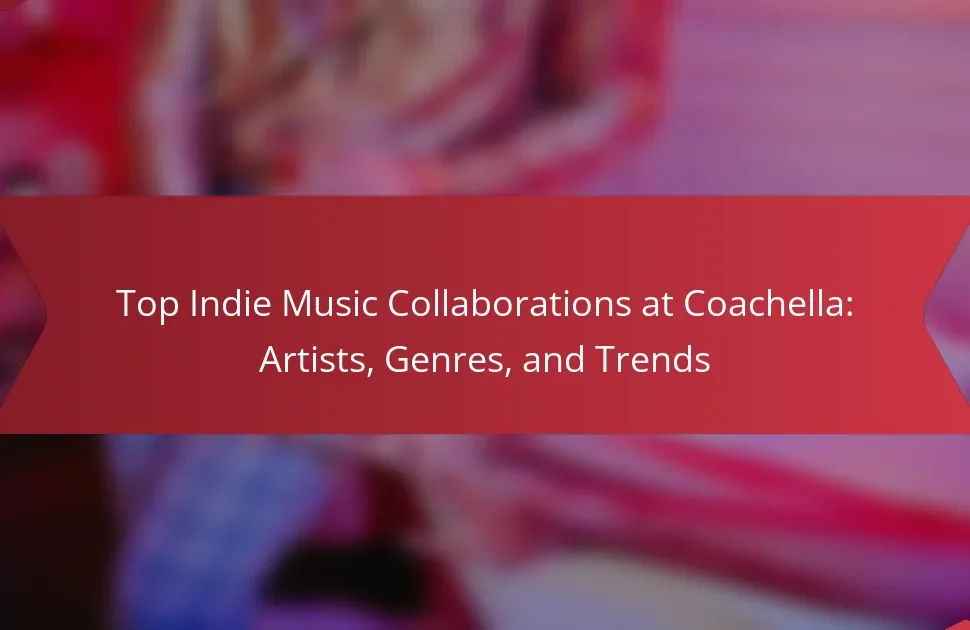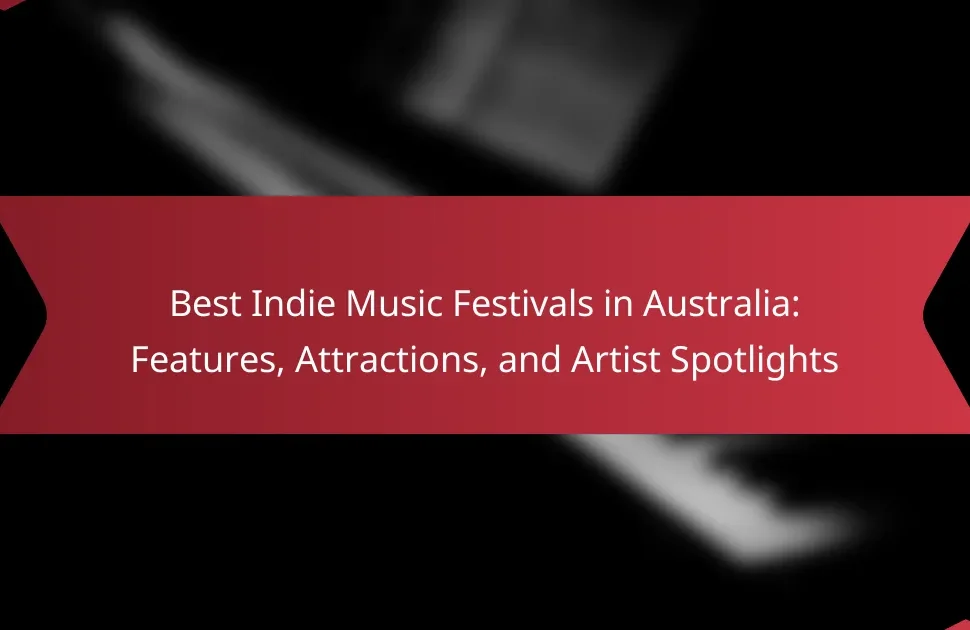Indie music festivals in Europe offer vibrant experiences that celebrate diverse lineups and foster community engagement. Key events like Primavera Sound and Glastonbury showcase emerging and established artists while emphasizing cultural impact. These festivals also prioritize sustainability, enhancing their appeal to environmentally conscious attendees. Additionally, local artists play a vital role in enriching the festival atmosphere and promoting regional talent.

What are the key features of indie music festivals in Europe?
Indie music festivals in Europe feature diverse lineups, unique locations, and a strong sense of community. These events often showcase emerging artists alongside established acts, creating a vibrant atmosphere. Festivals like Primavera Sound and Glastonbury emphasize cultural impact, fostering local talent and promoting artistic expression. Additionally, many festivals prioritize sustainable practices, enhancing their appeal to environmentally conscious attendees.
How do indie music festivals differ from mainstream music festivals?
Indie music festivals prioritize unique, emerging artists, while mainstream festivals focus on well-known headliners. Indie festivals often emphasize intimate settings and community engagement, showcasing diverse genres. For example, events like Primavera Sound and End of the Road highlight local talent and experimental sounds, contrasting with larger festivals like Coachella, which feature blockbuster acts. This cultural impact fosters a distinct atmosphere, attracting dedicated fans seeking authentic experiences.
What cultural significance do these festivals hold in European music scenes?
Indie music festivals in Europe hold significant cultural importance by fostering community, showcasing emerging talent, and promoting diverse musical expressions. These festivals often reflect local traditions and contemporary issues, creating a unique atmosphere that resonates with attendees. For instance, events like Primavera Sound and Glastonbury not only highlight popular acts but also provide platforms for underrepresented genres, enhancing cultural dialogue. Additionally, these festivals contribute to local economies and tourism, reinforcing their role as cultural hubs.
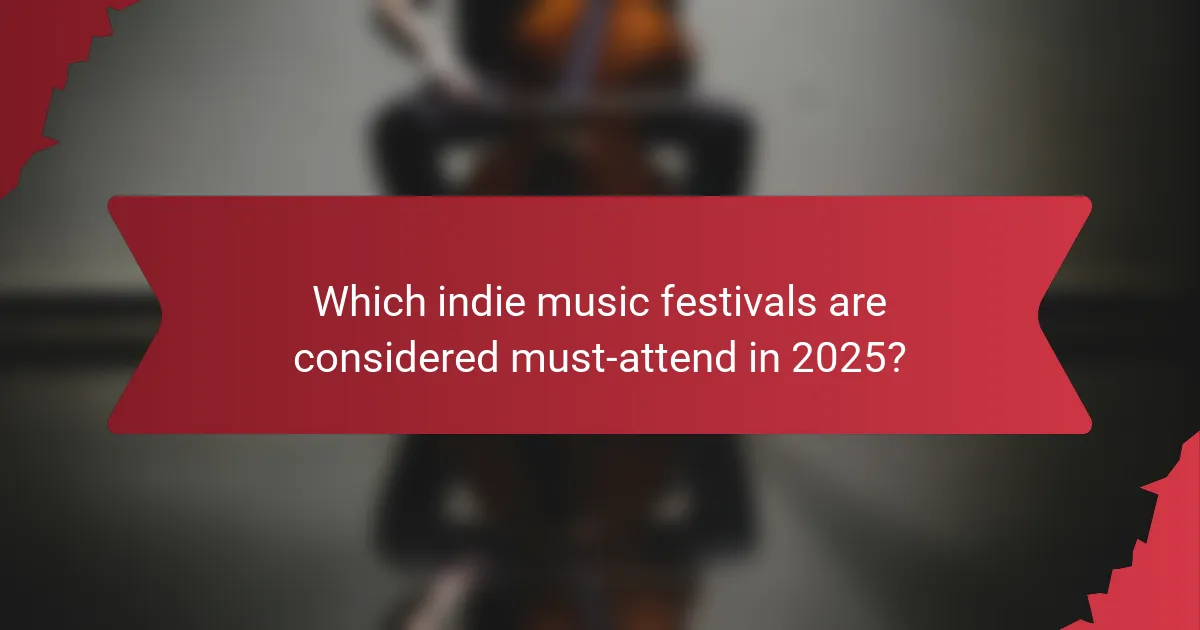
Which indie music festivals are considered must-attend in 2025?
The must-attend indie music festivals in 2025 include Primavera Sound, Glastonbury, and Sziget Festival. These events showcase diverse lineups and significant cultural impact across Europe.
Primavera Sound, held in Barcelona, features a blend of established and emerging artists, attracting a global audience. Glastonbury, the iconic festival in the UK, is known for its extensive lineup and vibrant atmosphere. Sziget Festival in Hungary combines music with arts and culture, creating a unique experience for attendees.
These festivals not only highlight musical talent but also foster community and creativity within the indie music scene.
What are the standout lineups for major indie festivals this year?
This year, standout lineups for major indie festivals in Europe include diverse artists and genres. Notable festivals such as Glastonbury, Primavera Sound, and Roskilde feature unique combinations of established and emerging talent. For instance, Glastonbury showcases headliners like Billie Eilish and Paul McCartney alongside indie favorites such as Fontaines D.C. Primavera Sound highlights acts like Arctic Monkeys and Halsey, while Roskilde presents a mix of local and international artists, emphasizing cultural diversity. These festivals not only celebrate music but also foster community and cultural exchange.
How do festival locations influence their themes and audiences?
Festival locations significantly shape their themes and audiences by providing unique cultural and geographical contexts. For instance, a festival held in a historic city may emphasize local traditions, attracting audiences interested in cultural experiences. In contrast, a rural setting might prioritize nature-inspired themes, appealing to eco-conscious attendees.
The ambiance of a location influences the type of music featured and the overall vibe. Festivals in urban areas often showcase diverse lineups, reflecting the cosmopolitan culture, while those in smaller towns may focus on regional artists.
Logistics also play a role; accessibility and accommodation options affect audience turnout and demographics. Festivals in well-connected cities tend to draw larger, more varied crowds compared to those in remote areas.
Ultimately, the interplay between location, theme, and audience creates distinctive festival identities, enriching the cultural landscape of indie music in Europe.
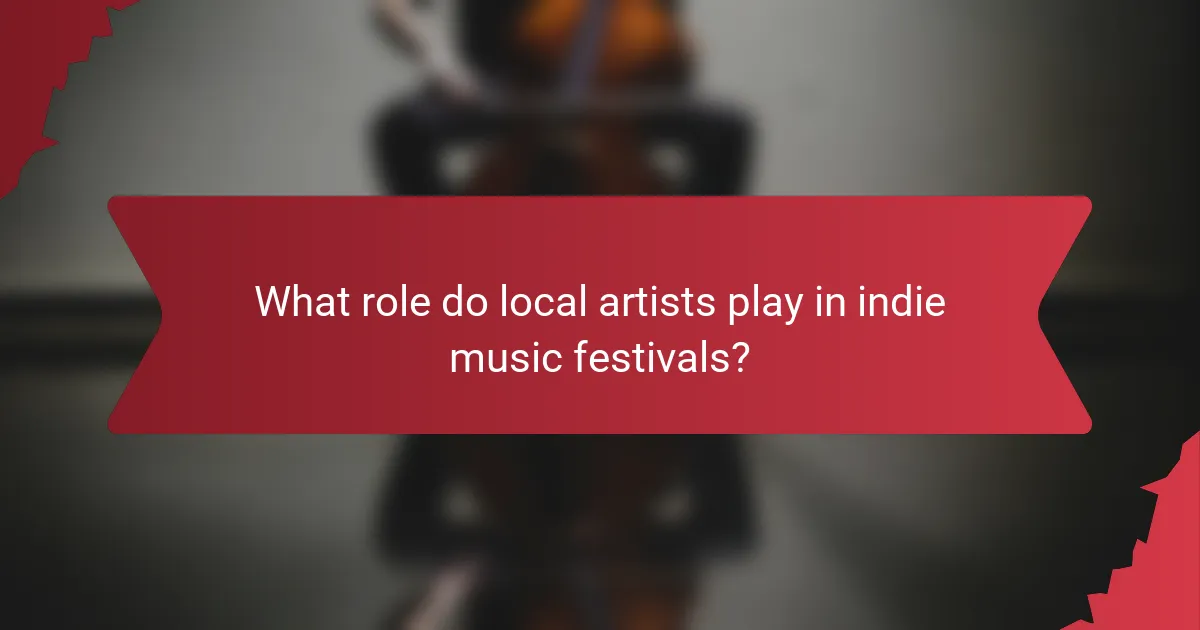
What role do local artists play in indie music festivals?
Local artists play a crucial role in indie music festivals by enhancing cultural diversity and community engagement. They often bring unique sounds and perspectives, enriching the festival experience for attendees. Local acts can serve as a bridge between the festival and the local community, fostering connections and promoting regional talent. Their performances often reflect local issues and narratives, making the music more relatable and impactful. Additionally, featuring local artists can help festivals build a loyal audience base, as attendees are likely to support homegrown talent.
How are emerging artists showcased at these events?
Emerging artists are showcased at indie music festivals through curated lineups, performance opportunities, and networking events. These festivals prioritize fresh talent, often featuring local and underground acts alongside established artists. This approach fosters cultural exchange and gives new musicians exposure to diverse audiences. Many festivals also provide platforms for artist collaboration and mentorship, enhancing their visibility and career growth.
What impact do local cultures have on festival programming?
Local cultures significantly influence festival programming by shaping themes, lineups, and audience engagement. Regional traditions often dictate the types of performances and artists featured, ensuring relevance and resonance with local attendees. For example, festivals in Spain may highlight flamenco artists, while those in Ireland focus on traditional Celtic music. Additionally, cultural values affect the festival atmosphere, promoting inclusivity or specific social messages. As a result, indie music festivals become platforms for cultural expression, reflecting and preserving local identities while attracting diverse audiences.
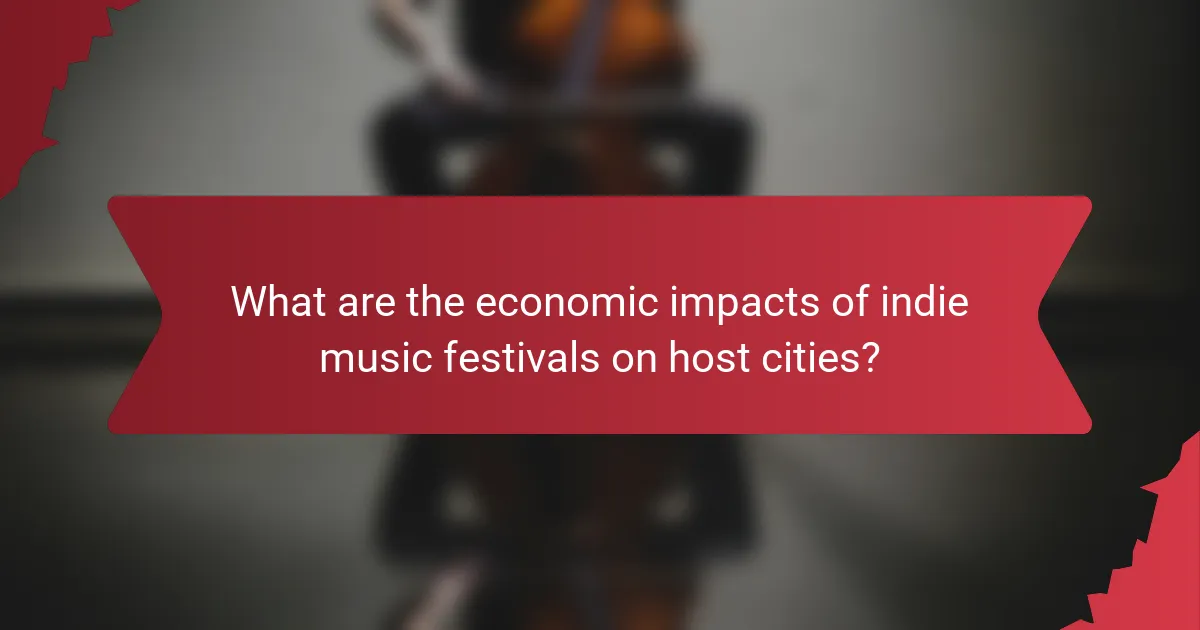
What are the economic impacts of indie music festivals on host cities?
Indie music festivals significantly boost host cities’ economies through increased tourism, local spending, and job creation. These events attract diverse audiences, leading to heightened demand for accommodations, food, and entertainment. For example, a study found that festivals can generate up to €2 million in local revenue. Additionally, they foster cultural exchange, enhancing the city’s profile as a vibrant destination. The unique atmosphere of indie festivals promotes community engagement, which can lead to long-term economic benefits.
How do festivals contribute to local tourism and business?
Festivals significantly boost local tourism and business by attracting diverse audiences. Indie music festivals in Europe draw thousands of visitors, enhancing local economies through increased spending on accommodations, food, and transportation. For instance, the annual Primavera Sound festival in Barcelona generates millions in revenue, benefiting local vendors and service providers. Additionally, these events foster cultural exchange and community engagement, solidifying the region’s identity and appeal. As a result, festivals become vital catalysts for sustainable tourism growth and local business success.
What challenges do cities face when hosting these events?
Cities face numerous challenges when hosting indie music festivals, including logistical issues, crowd management, and noise control. These events can strain local infrastructure, requiring extensive planning and resources. Additionally, balancing the interests of residents and festival-goers often leads to conflicts. Environmental concerns also arise, as large gatherings impact local ecosystems. Finally, securing funding and sponsorships can be difficult, affecting the festival’s sustainability.
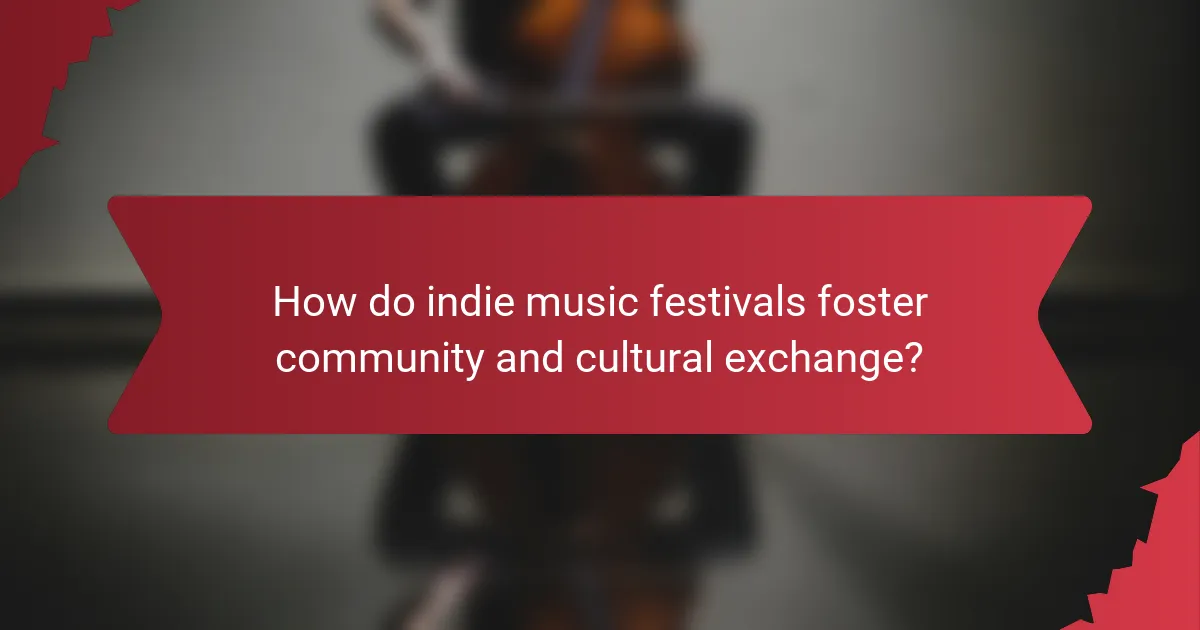
How do indie music festivals foster community and cultural exchange?
Indie music festivals foster community and cultural exchange by bringing diverse groups together to celebrate music and art. These events often feature local and international artists, encouraging collaboration and interaction among attendees.
Cultural exchange is enhanced as festival-goers experience different musical styles and traditions, promoting understanding and appreciation of various cultures. For example, festivals like Primavera Sound in Barcelona showcase artists from around the world, creating a melting pot of sounds and ideas.
Moreover, indie music festivals often emphasize sustainability and local engagement, fostering a sense of belonging. They provide platforms for local businesses and artisans, strengthening community ties.
Ultimately, these festivals serve as hubs for creativity and connection, enriching cultural landscapes across Europe.
What initiatives promote sustainability and inclusivity at festivals?
Indie music festivals in Europe promote sustainability and inclusivity through various initiatives. Many festivals implement waste reduction strategies, such as recycling programs and composting. They also prioritize local food vendors to support community economies and minimize carbon footprints. Additionally, festivals often feature diverse lineups that represent various cultures and backgrounds, fostering inclusivity. Some events provide accessibility options, ensuring all attendees can participate fully. By collaborating with environmental organizations, festivals enhance their sustainability efforts, creating a positive cultural impact.
How do these festivals create lasting connections among attendees?
Indie music festivals in Europe foster lasting connections among attendees through shared experiences and communal activities. These events create a sense of belonging as people gather to enjoy diverse lineups and discover new artists together.
Social interactions during festivals, such as conversations and collaborations, enhance emotional bonds. Attendees often form friendships based on mutual interests in music and culture. Unique attributes like local cuisine and art installations further enrich these connections, making each festival a memorable experience.
As a result, many attendees return year after year, strengthening their ties to the festival community. This ongoing engagement contributes to a vibrant cultural impact, as festivals become integral to the social fabric of the regions they inhabit.
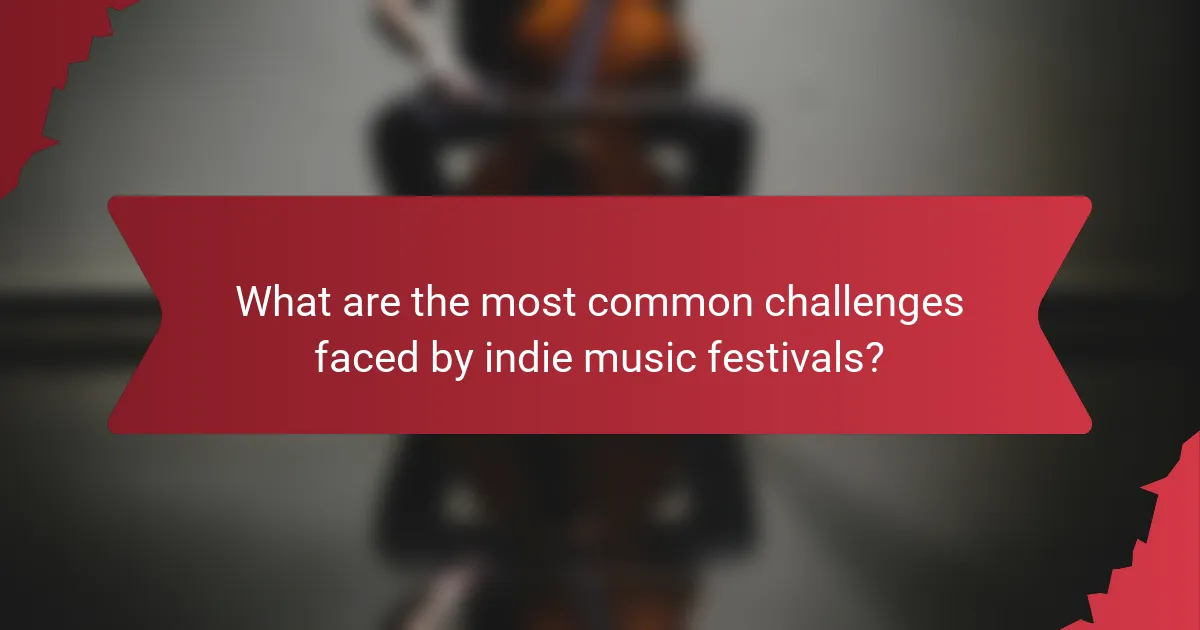
What are the most common challenges faced by indie music festivals?
Indie music festivals commonly face challenges such as funding, artist availability, weather conditions, and audience engagement. These factors can significantly impact the festival’s success and cultural impact.
Funding is often a major hurdle, with many festivals relying on sponsorships and ticket sales. Artist availability can fluctuate, making it difficult to secure desired lineups. Weather conditions pose risks, particularly for outdoor events, which can affect attendance and logistics. Lastly, engaging audiences in a saturated market requires innovative programming and marketing strategies.
How do organizers manage funding and sponsorships?
Organizers manage funding and sponsorships by building relationships with brands, leveraging ticket sales, and applying for grants. They seek partnerships that align with the festival’s values and audience. Sponsorships often include financial support in exchange for brand exposure. Additionally, successful festivals may utilize crowdfunding to engage their community and raise funds directly from fans.
What logistical issues arise during festival planning and execution?
Logistical issues during festival planning and execution include venue selection, crowd management, and transportation. Limited resources can hinder effective coordination. Weather conditions may disrupt schedules, impacting performance and attendee experience. Additionally, safety regulations and emergency preparedness are crucial for minimizing risks.
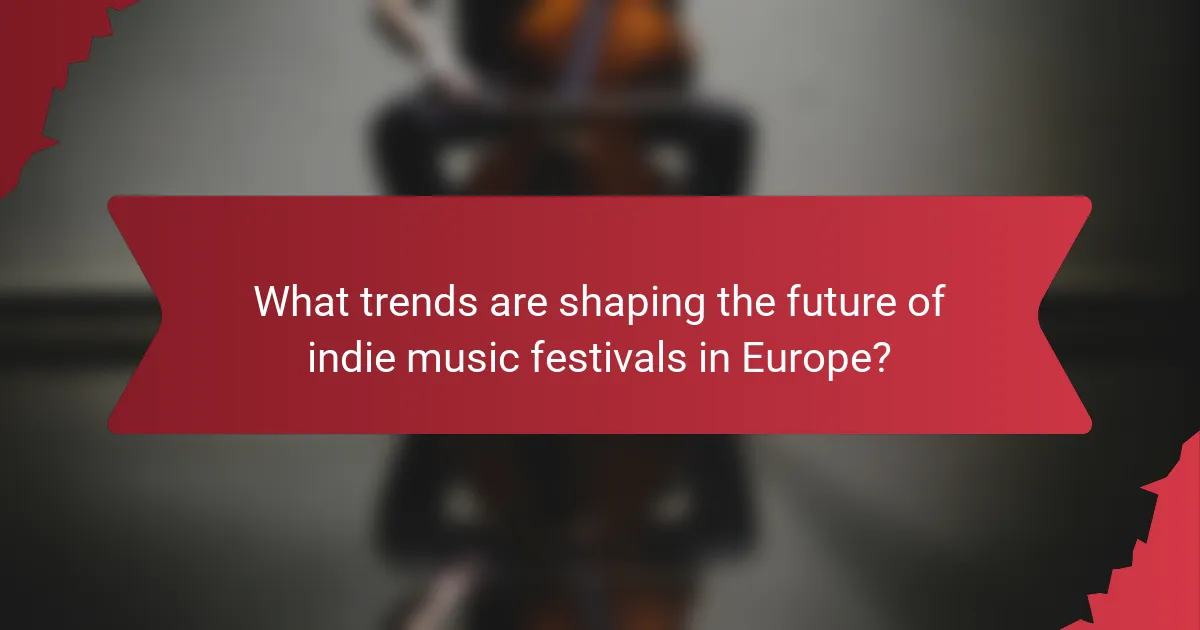
What trends are shaping the future of indie music festivals in Europe?
Indie music festivals in Europe are increasingly shaped by sustainability, diversity, and digital engagement. Festivals prioritize eco-friendly practices, featuring local artists and inclusive lineups. Virtual experiences and social media interactions enhance audience engagement, reflecting a shift in how festivals connect with fans. These trends signify a broader cultural impact, making festivals more relevant and accessible.
How is technology influencing festival experiences?
Technology is enhancing festival experiences by improving accessibility, engagement, and convenience. Innovations like mobile apps provide real-time updates, enabling attendees to navigate lineups and schedules effortlessly. Virtual reality experiences allow fans to immerse themselves in performances from anywhere, broadening audience reach. Additionally, social media platforms foster community connections, allowing festival-goers to share experiences instantly. These advancements contribute to a more interactive and memorable atmosphere at indie music festivals across Europe.
What innovative practices are being adopted for audience engagement?
Innovative practices for audience engagement at indie music festivals in Europe include interactive experiences, enhanced digital platforms, and community involvement. Festivals are utilizing augmented reality to create immersive environments, allowing attendees to engage with performances in novel ways. Social media campaigns foster real-time interaction, encouraging fans to share their experiences and connect with artists. Additionally, many festivals are incorporating local culture into their programming, inviting community artists to participate, which strengthens ties between the festival and its locale. This approach not only enriches the festival experience but also promotes cultural diversity and community support.
What are the best practices for attending and enjoying indie music festivals?
To fully enjoy indie music festivals, plan ahead, stay hydrated, and immerse yourself in the cultural experience. Research the lineup and festival schedule to prioritize must-see acts. Arrive early to explore the venue, discover local vendors, and engage with fellow festival-goers. Dress comfortably for the weather and wear appropriate footwear for walking. Be open to new sounds and artists, as indie festivals often showcase emerging talent. Lastly, respect the environment and fellow attendees by following festival guidelines.
